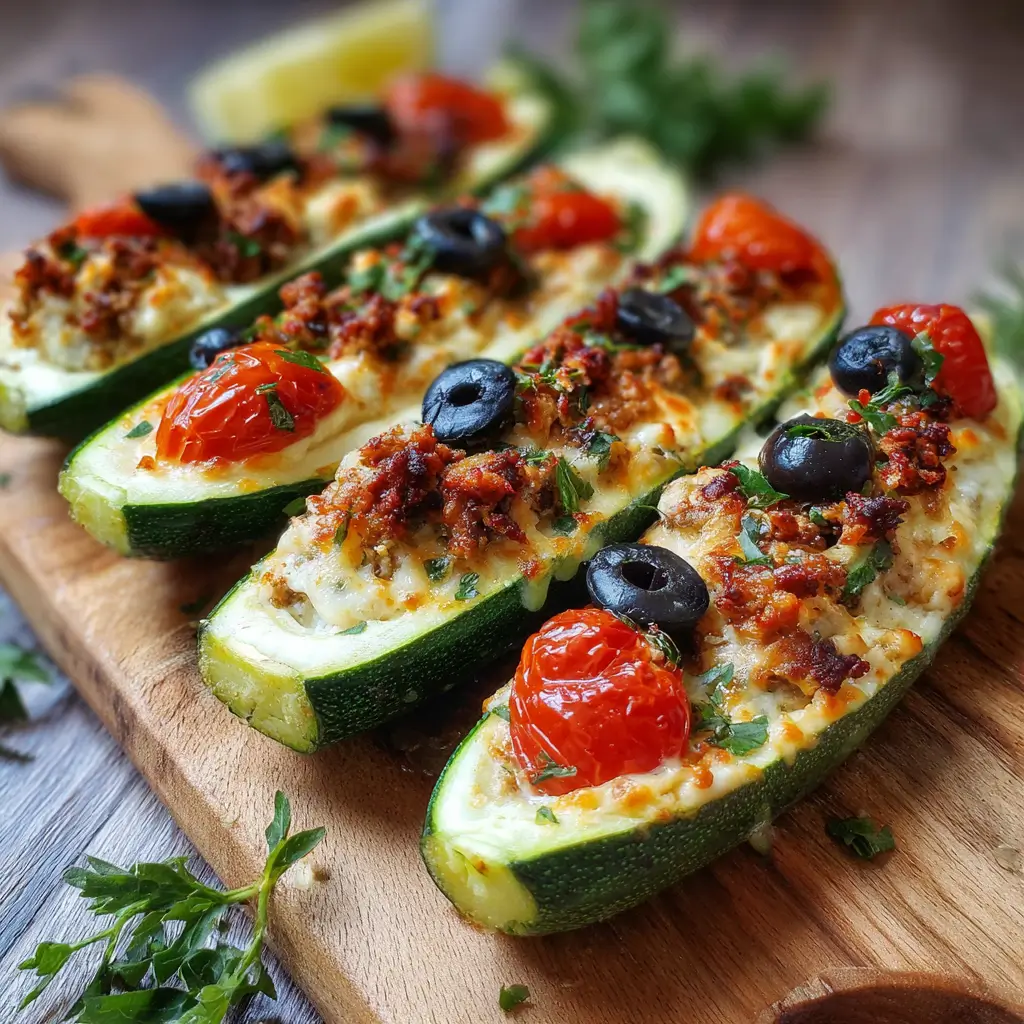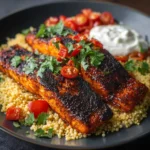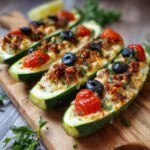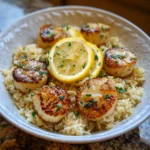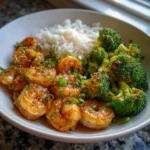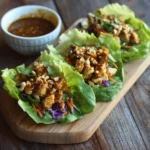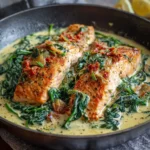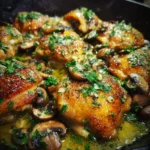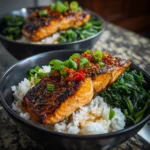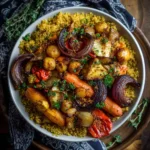Mediterranean Stuffed Zucchini Boats
The Mediterranean diet is celebrated worldwide not only for its rich flavors but also for its health benefits, and few dishes embody this culinary philosophy as beautifully as Mediterranean Stuffed Zucchini Boats. These vibrant, nutrient-packed boats are a celebration of fresh vegetables, whole grains, herbs, and wholesome proteins, all nestled inside tender zucchini halves. Whether you’re looking for a light summer dinner, a gluten-free meal option, or a plant-forward dish to impress guests, these stuffed zucchinis deliver on every front. With layers of flavor inspired by Greece, Italy, and the Levant, this recipe brings the sun-drenched shores of the Mediterranean right to your kitchen table.
The History
Stuffed vegetable dishes have deep roots in Mediterranean and Middle Eastern cuisines, dating back centuries. Known as “dolma” in Turkish and Greek traditions—though dolma typically refers to stuffed grape leaves—the concept of hollowing out vegetables and filling them with aromatic mixtures has long been a staple across the region. In countries like Greece, Lebanon, Turkey, and Italy, seasonal produce such as tomatoes, peppers, eggplants, and zucchinis are often transformed into edible vessels for rice, herbs, spices, and sometimes meat.
Zucchini, originally from the Americas but widely adopted in Europe after the Columbian Exchange, became especially popular in Italian and Balkan cooking during the 19th century. As farming practices evolved and summer squash became more accessible, recipes featuring stuffed zucchini emerged throughout southern Europe. The modern version of Mediterranean Stuffed Zucchini Boats reflects both tradition and innovation—honoring ancestral techniques while adapting to contemporary dietary preferences like vegetarianism, veganism, and gluten-free lifestyles. Today, this dish stands as a testament to the Mediterranean’s enduring influence on global cuisine.
Ingredients Breakdown
The magic of Mediterranean Stuffed Zucchini Boats lies in the harmony of its ingredients—each one contributing texture, aroma, color, and nutrition. Here’s an in-depth look at what goes into this flavorful masterpiece:
- Zucchinis – The star of the show. Medium to large zucchinis provide a mild, slightly sweet base that becomes tender when baked. They’re low in calories yet high in water content and fiber, making them ideal for stuffing without overpowering other flavors.
- Olive Oil – Extra virgin olive oil is central to Mediterranean cooking. It adds richness, enhances browning, and carries the flavors of herbs and spices. Its heart-healthy monounsaturated fats make it a cornerstone of the Mediterranean diet.
- Onion and Garlic – These aromatics form the flavor foundation. Yellow onion offers sweetness when sautéed, while garlic contributes pungency and depth. Together, they create a savory base for the stuffing.
- Bell Peppers – Red or yellow bell peppers add natural sweetness, vibrant color, and a juicy crunch. Rich in vitamin C and antioxidants, they enhance both taste and nutritional value.
- Tomatoes – Fresh diced tomatoes or sun-dried tomatoes can be used. They bring acidity, moisture, and umami to balance the dish. Roma tomatoes are preferred for their lower water content.
- Cooked Quinoa or Bulgur Wheat – A protein-rich grain alternative (quinoa) or traditional Middle Eastern grain (bulgur) serves as the stuffing base. Both absorb flavors well and offer complex carbohydrates and fiber.
- Feta Cheese – Salty, tangy feta made from sheep or goat milk is quintessentially Mediterranean. It melts slightly during baking, adding creaminess and bold flavor. For a vegan version, dairy-free feta works beautifully.
- Kalamata Olives – These briny, purple olives are a signature ingredient. Chopped finely, they infuse the filling with a robust, salty bite that complements the milder components.
- Fresh Herbs – Parsley, oregano, and dill are commonly used. Flat-leaf parsley brings freshness, oregano imparts earthiness, and dill adds a subtle anise-like note common in Greek cuisine.
- Lemon Juice – A splash brightens the entire dish, cutting through richness and enhancing the perception of freshness.
- Pine Nuts or Walnuts – Toasted nuts add a buttery crunch and boost healthy fats. Pine nuts are traditional, but walnuts offer a more affordable, omega-3-rich alternative.
- Spices – Ground cumin, paprika, and black pepper round out the seasoning profile, adding warmth and complexity without overwhelming heat.
Step-by-Step Recipe
- Preheat the Oven: Set your oven to 375°F (190°C). Line a large baking sheet with parchment paper or lightly grease it with olive oil to prevent sticking.
- Prepare the Zucchinis: Wash 4 medium zucchinis thoroughly. Trim off both ends, then cut them lengthwise in half. Using a spoon or melon baller, carefully scoop out the center flesh, leaving about a ¼-inch thick wall to maintain structure. Reserve the scooped-out pulp for the filling.
- Salt the Zucchini Halves (Optional): To reduce excess moisture, sprinkle the insides of the zucchini boats with salt and let them sit for 10–15 minutes. Blot dry with paper towels before using. This step ensures firmer boats and prevents sogginess.
- Chop the Filling Ingredients: Dice the reserved zucchini pulp, 1 medium onion, 1 red bell pepper, 2 cloves of garlic (minced), and 1 ripe tomato. Chop ¼ cup Kalamata olives and ¼ cup fresh parsley. Measure out ½ cup crumbled feta cheese and 2 tablespoons toasted pine nuts or walnuts.
- Sauté the Vegetables: Heat 2 tablespoons extra virgin olive oil in a large skillet over medium heat. Add the onions and sauté until translucent (about 5 minutes). Add the garlic and cook for 30 seconds until fragrant. Stir in the bell pepper, reserved zucchini pulp, and tomato. Cook for 6–8 minutes, until softened and most liquid has evaporated.
- Add Grains and Seasonings: Stir in 1 cup cooked quinoa or bulgur wheat. Mix in 1 teaspoon dried oregano, ½ teaspoon ground cumin, ¼ teaspoon smoked paprika, salt (to taste), and freshly ground black pepper. Squeeze in juice from half a lemon and stir well.
- Incorporate Herbs and Cheese: Remove the skillet from heat. Fold in chopped parsley, olives, toasted nuts, and crumbled feta. Taste and adjust seasoning—add more lemon, salt, or herbs as needed.
- Stuff the Zucchini Boats: Place the prepared zucchini halves on the baking sheet, cut side up. Spoon the filling mixture evenly into each boat, mounding it slightly. Use the back of the spoon to press down gently so the filling holds together.
- Drizzle and Bake: Drizzle the tops with a little more olive oil and a sprinkle of paprika or oregano for color. Bake for 25–30 minutes, or until the zucchini is fork-tender and the tops are lightly golden.
- Optional Broil: For a crispier top, switch the oven to broil for the last 2–3 minutes, watching closely to avoid burning.
- Serve Warm: Let cool for 5 minutes before serving. Garnish with extra crumbled feta, a drizzle of olive oil, fresh dill, or microgreens if desired.
Tips
- Choose Uniform Zucchinis: Pick zucchinis of similar size for even cooking. Avoid overly large ones, which may have tough seeds and watery flesh.
- Don’t Skip the Pre-Salting Step: While optional, salting and draining the zucchini helps remove excess moisture, preventing soggy boats and improving texture.
- Toast Your Nuts: Lightly toast pine nuts or walnuts in a dry pan before adding them to enhance their nutty flavor and crunch.
- Use Cooked Grain: Prepare quinoa, rice, or bulgur ahead of time. You can use leftovers to save time—just ensure it’s cooled before mixing into the filling.
- Bake on a Rack for Crispness: For extra browning underneath, place a wire rack on the baking sheet and arrange the boats on top.
- Watch Baking Time: Overbaking can cause the zucchini to collapse. Check for doneness at 25 minutes; they should yield easily to a fork but still hold their shape.
- Let Them Rest: Allow the boats to rest for 5 minutes after baking so the filling sets and flavors meld.
- Double the Batch: These freeze well! Bake, cool completely, wrap individually, and freeze for up to 3 months. Reheat in the oven at 350°F for 20–25 minutes.
Variations and Customizations
Mediterranean Stuffed Zucchini Boats are incredibly versatile—perfect for tailoring to different tastes, diets, and seasonal ingredients. Here are some creative twists:
- Vegan Version: Omit feta or use plant-based cheese. Add capers or miso paste for a salty kick. Nutritional yeast can add a cheesy flavor.
- Meat Lovers’ Option: Brown ½ pound of ground lamb, turkey, or beef and mix it into the filling. Traditional Greek gemista often includes spiced meat.
- Gluten-Free Friendly: This recipe is naturally gluten-free when using quinoa or certified gluten-free grains. Always check labels on bulgur or packaged ingredients.
- Dairy-Free: Replace feta with avocado slices or white beans for creaminess. Tahini mixed into the filling adds richness.
- Low-Carb/Keto: Replace grains with finely chopped mushrooms, cauliflower rice, or lentils. Increase cheese and nuts for satiety.
- Extra Veggies: Add spinach, artichoke hearts, roasted red peppers, or eggplant to the filling for more volume and nutrients.
- Herb Variations: Try mint instead of dill, or add basil for an Italian twist. Thyme and rosemary work well in winter versions.
- Grain Swaps: Use farro, brown rice, freekeh, or couscous depending on availability and preference. Adjust liquid and cooking time accordingly.
- Spicy Kick: Add red pepper flakes, harissa paste, or diced jalapeños for heat.
- Breakfast Boats: Fill with scrambled eggs, spinach, and feta for a brunch-friendly version.
Health Considerations and Nutritional Value
Mediterranean Stuffed Zucchini Boats are not only delicious but also remarkably nutritious, aligning perfectly with wellness-focused eating patterns. Here’s why this dish supports overall health:
- Low in Calories, High in Volume: Zucchini is mostly water and fiber, promoting fullness without excess calories. One medium zucchini contains only about 30–40 calories.
- Rich in Fiber: The combination of vegetables, whole grains, and legumes (if added) provides ample dietary fiber, supporting digestive health and stable blood sugar levels.
- Heart-Healthy Fats: Olive oil, nuts, and olives contribute monounsaturated and polyunsaturated fats, which help reduce LDL (“bad”) cholesterol and support cardiovascular health.
- Antioxidant Powerhouse: Tomatoes contain lycopene, bell peppers are loaded with vitamin C, and herbs like oregano are rich in polyphenols—all known for their anti-inflammatory and disease-preventing properties.
- Plant-Based Protein: Quinoa is a complete protein, containing all nine essential amino acids. When combined with legumes or nuts, the dish becomes an excellent source of plant protein.
- Calcium and Bone Health: Feta cheese provides calcium and phosphorus, important for strong bones and teeth—though in moderation due to sodium content.
- Low Glycemic Index: Whole grains and fiber slow glucose absorption, making this dish suitable for those managing diabetes or insulin resistance.
- Sodium Note: Feta and olives are naturally high in sodium. For a lower-sodium version, use reduced-salt feta, rinse olives, or decrease quantity. Boost flavor with lemon and herbs instead.
- Hydration Support: Zucchini’s high water content contributes to daily fluid intake, aiding hydration—especially valuable in hot weather.
This dish exemplifies the principles of the Mediterranean diet, consistently ranked among the healthiest in the world. Studies link this eating pattern to reduced risks of heart disease, stroke, type 2 diabetes, and certain cancers.
Ingredients
- 4 medium zucchinis
- 2 tbsp extra virgin olive oil (plus extra for drizzling)
- 1 medium yellow onion, finely diced
- 2 cloves garlic, minced
- 1 red bell pepper, diced
- 1 medium tomato, seeded and diced
- Flesh from scooped zucchinis (about 1.5 cups)
- 1 cup cooked quinoa or bulgur wheat
- ½ cup crumbled feta cheese
- ¼ cup chopped Kalamata olives
- ¼ cup toasted pine nuts or walnuts
- ¼ cup fresh parsley, finely chopped
- 1 tsp dried oregano
- ½ tsp ground cumin
- ¼ tsp smoked paprika
- Juice of ½ lemon
- Salt and freshly ground black pepper to taste
- Optional: fresh dill, mint, or oregano for garnish
Directions
- Preheat oven to 375°F (190°C). Line a baking sheet with parchment paper.
- Cut zucchinis in half lengthwise. Scoop out centers, leaving ¼-inch walls. Chop the pulp and set aside. Optional: salt insides and let sit 10–15 minutes, then pat dry.
- In a large skillet, heat olive oil over medium heat. Add onion and sauté until soft (5 minutes).
- Add garlic and cook 30 seconds until fragrant.
- Stir in bell pepper, chopped zucchini pulp, and tomato. Cook 6–8 minutes until softened and excess liquid evaporates.
- Mix in cooked quinoa, oregano, cumin, paprika, salt, and pepper. Stir well.
- Remove from heat. Add lemon juice, parsley, olives, nuts, and feta. Adjust seasoning.
- Place zucchini halves on baking sheet. Spoon filling into each boat, pressing gently to pack.
- Drizzle tops with olive oil and sprinkle with paprika.
- Bake 25–30 minutes until zucchini is tender and tops are golden.
- Optional: Broil 2–3 minutes for crispier topping.
- Rest 5 minutes. Garnish and serve warm.
FAQ
Can I make these ahead of time?
Yes! Assemble the boats up to one day in advance and refrigerate unbaked. Add 5–10 minutes to baking time if starting cold. You can also bake them ahead and reheat in the oven at 350°F for 15 minutes.
How do I store leftovers?
Store cooled leftovers in an airtight container in the refrigerator for up to 4 days. Reheat in the oven or microwave.
Can I freeze stuffed zucchini boats?
Absolutely. Bake, cool completely, wrap individually in foil or plastic, and freeze for up to 3 months. Reheat from frozen at 350°F for 25–30 minutes.
Why are my zucchini boats soggy?
This usually happens due to excess moisture. Be sure to salt and drain the zucchini halves before stuffing, and cook the filling until most liquid has evaporated.
What can I serve with stuffed zucchini boats?
They pair wonderfully with a Greek salad, tzatziki sauce, hummus, grilled pita, or a simple arugula salad with lemon vinaigrette. For a heartier meal, serve with grilled chicken or fish.
Are these gluten-free?
Yes, if you use a gluten-free grain like quinoa or certified gluten-free bulgur. Double-check labels if cross-contamination is a concern.
Can I use rice instead of quinoa?
Yes! Cooked brown or white rice works well. Use about 1 cup cooked rice as a substitute.
Is this recipe kid-friendly?
Many children enjoy the cheesy, savory flavor. Try finely dicing the veggies or letting kids help stuff the boats—it makes them more likely to eat it!
Summary
Mediterranean Stuffed Zucchini Boats are a wholesome, flavorful dish that combines fresh vegetables, aromatic herbs, whole grains, and feta cheese in tender zucchini shells, baked to perfection. Celebrated for their versatility, nutrition, and vibrant taste, they’re a delicious way to embrace the heart-healthy principles of Mediterranean cuisine.
